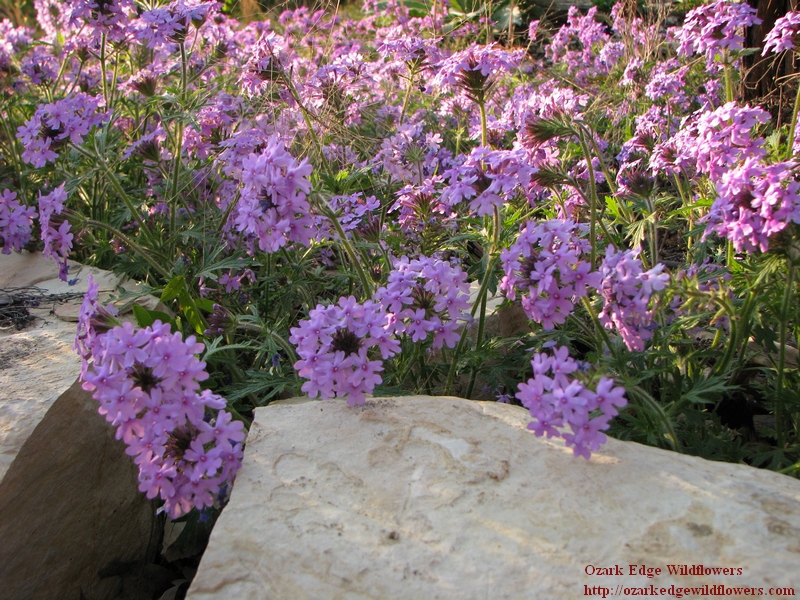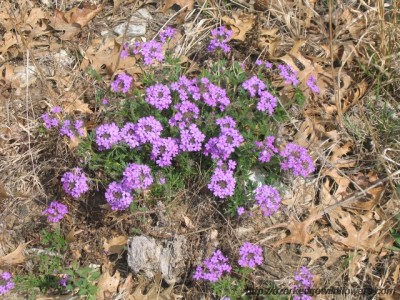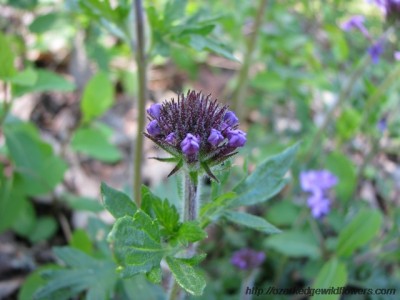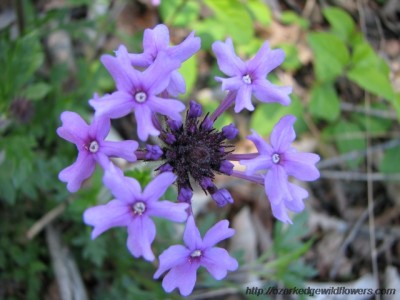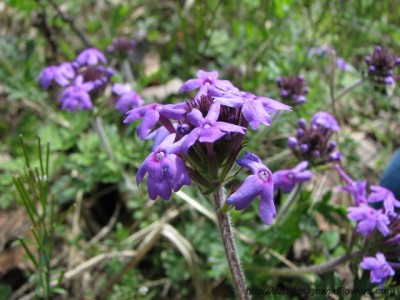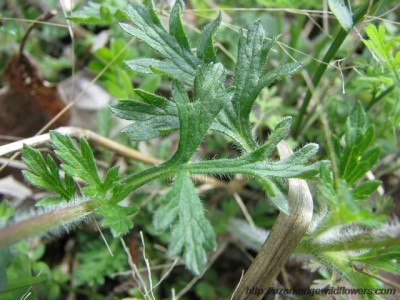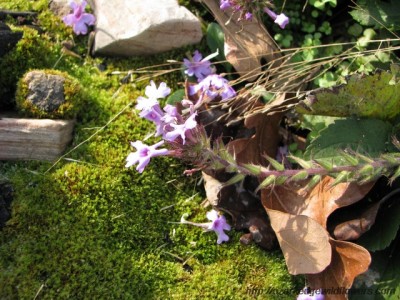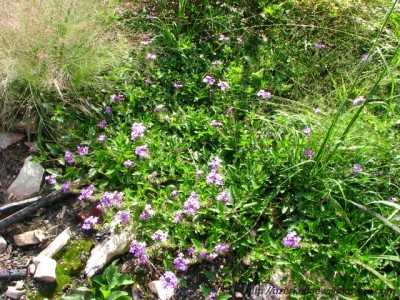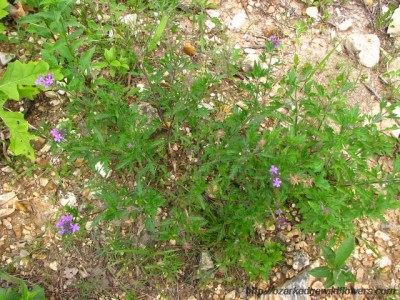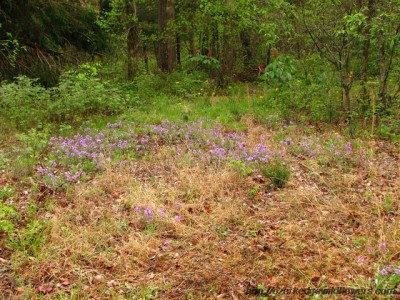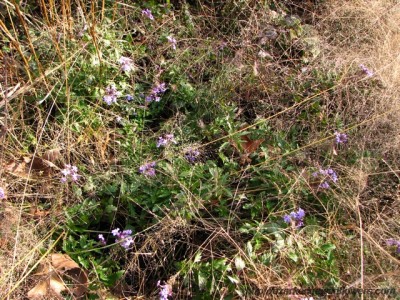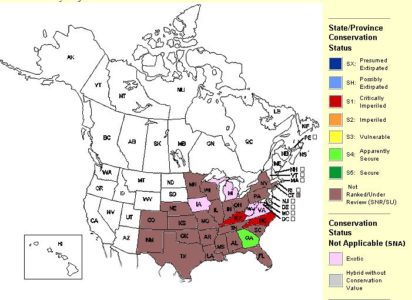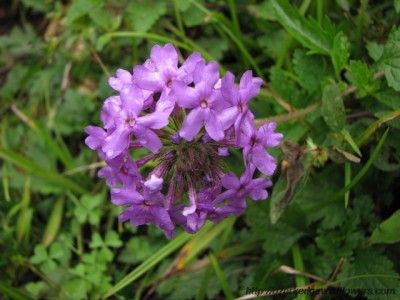What plant on Ozarkedge has the longest bloom time? The prize easily goes to Glandularia canadensis! You can catch this tough little plant in bloom anytime from the cold of March through steamy June and the drought of August. The blooms will slow during periods of drought and then pick right back up and continue through fall and even into December. In fact, January and February are the only months in which I have NOT seen this wonderful native in bloom. Not only is Rose verbena a long bloomer—it is beautiful as well.
Latin Name/Common Name- Glandularia canadensis is in the Verbenaceae or Vervain family. This family includes the fragrant herb Lemon Verbena. Other native ozark wildflowers in this family include Verbena simplex (Narrow-leaved vervain), Verbena stricta (Hoary vervain) and Verbena hastata (Blue vervain).
Glandularia canadensis is my favorite of all of the above. Common names include Rose verbena, Rose vervain or Rose mock vervain. If you purchase ‘Homestead Purple’ verbena at a nursery, you are purchasing a cultivar of the native Rose verbena. But, no cultivar can truly compete with the hardiness, long bloom time and beauty of the native Rose verbena in its habitat.
The most current latin name is Glandularia canadensis. It was formerly known as Verbena canadensis. The genus name- Glandularia- refers to glands found on many of these plants. The term canadensis means ‘of Canada’, which is a bit confusing since Rose verbena is not native to Canada. There are a lot of plants with the term canadensis and the reason is that Linnaeus, the 18th century botanist who first described many species used the term ‘Canada’ to refer to most of northeastern North America, which now mostly consists of the United States.
Bloom Color- The blooms are a lovely purple, varying from pink, magenta and lavender-purple. I think the color is especially beautiful against the stones on Ozarkedge.
Description- Rose verbena is a low, sprawling plant that creeps along the ground and trails over large stone. It easily goes unnoticed when not in bloom. Where stems touch the ground, a node may root and send up new shoots. The foliage stays green well into winter, surviving hard frosts. Stems are hairy and the opposite leaves are divided into 3 or more lobes. The flowers appear in a cluster, with each being no more than a 1/2 ” sized tube with 5 lobes or petals. The flowering stems may trail or rise from the creeping plant up to a foot or two.
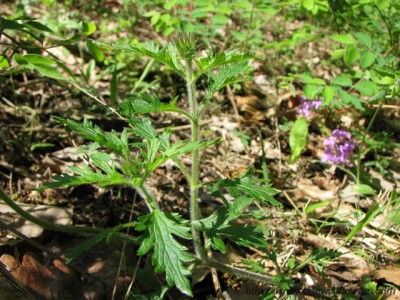
Bloom Time- As I mentioned, this is the longest blooming plant on Ozarkedge. I’ve documented it in flower from March to December. Blooming decreases during the driest and hottest parts of the summer, but I’ve found it blooming when everything else looks withered and scorched by the sun.
Rose Verbena in bloom December, 2009
Habitat- Cedar glades and open prairies are a common habitat for Rose verbena. It is able to thrive on thin soil in the rockiest areas of Ozarkedge- as long as there is sun and occasional rain. Rocky woods are also a common habitat, but it will not tolerate too much shade.
What’s Growing Nearby? – In the spring, red buckeye and dogwood can be seen in the background of my photos of Rose verbena. In open woods, Senecio obovatus (Roundleaf groundsel) provides a yellow contrast with the purple blossoms in spring. The white blooms of Penstemon pallidus (Pale beardtongue) are a little later companion. In the fall, pink muhly grass provides a soft pink glow surrounding Rose verbena.
Red Buckeye at the woodland edge behind Rose verbena
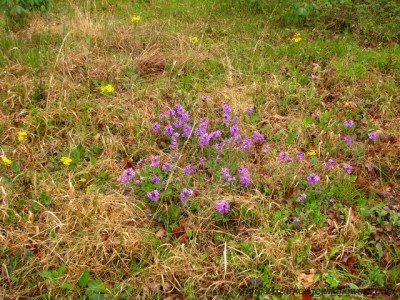
Roundleaf groundsel provides a yellow contrast
Pink muhly grass and Rose verbena in the fall
Endangered List- Glandularia canadensis is such a hardy plant that I was surprised to find it listed on the USDA Plant Site as threatened in Kentucky. (http://plants.usda.gov/java/profile?symbol=GLCA2). But, we are losing habitat for all of our native plants and Kentucky lists this beauty as threatened.
Natureserve lists it as Critically Imperiled in both Kentucy and North Carolina. It’s Apparently Secure in Georgian and Unranked across the rest of its native habitat. This is hard for me to take in as this is such an impressive native wildflower. It’s so easy to grow and as so many attributes—long bloom time, beautiful flowers, drought tolerant and attracts many beneficial insects such as hummingbird moths, bees, butterflies and many more.
*NatureServe. 2018. NatureServe Explorer: An online encyclopedia of life [web application]. Version 7.1. NatureServe, Arlington, Virginia. Available http://explorer.natureserve.org. (Accessed: March 9, 2019 ).
Interesting Tidbits- Butterflies and other insects are attracted to the bright flowers of Rose verbena. Black swallowtails and painted ladies are two of the butterflies that are common visitors.
